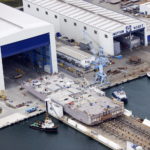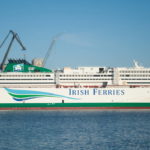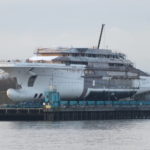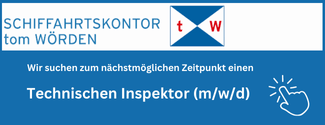The core competency of German shipbuilders is still the construction of specialized vessels, but the number of deliveries decreased again in 2018. Shipyard cooperations, on the other hand, continue. By Thomas Wägener
Modern vessels become more and more complex – for the present and future. One trend is LNG as fuel especially for[ds_preview] cruise ships. For example, all vessels in the Meyer Group order book will rely on this kind of more environmentally friendly fuel.
Because of growing complexity, ships tend to pass through more than one shipyard location more frequently while under construction. In the past that was especially noticeable for naval vessels. The new frigates for the German Navy built by Lürssen and ThyssenKrupp Marine Systems (TKMS) bear witness to this evolution. After the bow section had been built by Lürssen, the vessels were shipped to TKMS Hamburg. The first two of four units will be delivered this year, with the remaining two to follow in 2020.
Now this trend has become clear in the construction of cruise vessels also with Meyer Group as an example. The engine component sections for seagoing cruisers are constructed by Neptun shipyard in Rostock-Warnemünde, an affiliate. All propulsion and supply systems for big seagoing cruisers are accommodated in the complex modules on four decks. That includes everything from the ship’s engines to power generators, heating and air-conditioning technology to tanks for liquefied natural gas (LNG).
In August last year the first floating engine room module (FERU) of 140m length and 42m width was build in the new production hall. The facility of 180m x 65m x 58m (length, width, height) started operation in spring 2018.
The floating engine room module was transferred by sea to Meyer shipyard in Papenburg. It was installed on the cruise ship »Norwegian Encore« which is planned to be handed over in autumn this year.
Yards strengthen the capacity
»The hall offers all the structural and technical prerequisites to deliver four FERUs per year in the recent future and even six beyond. In addition, we are significantly increasing our productivity,« says Manfred Ossevorth, Managing Director of Neptun Werft. Both FERUs for »Norwegian Bliss« and »AIDAnova«, two cruisers delivered last year, were manufactured at Neptun shipyard.
Prospective FERUs for big cruise vessels from Papenburg and Turku will be built there. The Meyer Group order book lists a total of 23 new cruise ships. Such utilization secures employment until the end of 2023, the company stated. All of these units will be manufactured at the shipyards in Papenburg, Rostock and Turku by 2024. Rostock will predominantly build river cruisers for long-term customer Viking River Cruises. Six of them will be delivered soon. All belong to the famous Longship class of which the yard has constructed more than 50 units in the past.
From 2019 on, Meyer Group plans to deliver three seagoing cruise vessels a year. In the past usually two ships were handed over to customers year by year. To deal with this increase, the number of employees in Germany grew by 400 last year. But the company is still looking for further employees, both in the commercial sector as well as IT specialists, says CEO Tim Meyer.
MV Werften with locations in Wismar, Stralsund and Rostock-Warnemünde is another shipbuilding company that prepares for a more effective production. To achieve this objective, the company also initiates several strategic steps. The most recent one is the acquisition of Neptun Ship Design headquartered in Rostock. As a result of the purchase, the shipyard group will be joined by 120 experts, MV Werften announced.
The company owned by Genting Group from Hong Kong is currently preparing the construction of the »Global Class« cruise ships, which will be the biggest cruisers build in Germany to date, and the expedition ship »Crystal Endeavor«, which was laid on keel in Mid-January. The new constructing engineers and designers will mainly be employed for the design of new ship projects.
»It is time to take on the challenges of engineering the world’s most modern passenger ships as well as for the entire current and future product portfolio,« comments Stephan Merkel, CEO of Neptun Ship Design. Current projects will also be continued under the new owner.
The purchase agreement has already been signed, but antitrust approval is still pending. The parties have agreed not to disclose the structure of the transaction or the purchase price.
Last year MV Werften delivered the river cruisers »Crystal Debussy« and »Crystal Ravel«, the last two of four units for Crystal River Cruises. There is some evidence that it will be the last ships of this type for a long time, as in 2018 the shipyard announced to concentrate on building seagoing vessels in the future.
Another competence of German shipbuilders is to manufacture mega yachts. Lürssen Group delivered one unit in 2018. At 136m length the ship bears the project name »Thunder«. Research has shown that it has entered service as »Crescent«. In addition there are several projects in the order books, some of them have passed seatrails. In contrast, project »Sassi« is no longer pending, as the vessel was damaged in a fire in September it is due to be scrapped in Hamburg including the floating dock.
In addition to the naval orders with TKMS, Lürssen also cooperates with German Naval Yards for an explorer yacht. The construction should start at Peenewerft in Wolgast this year, later on the vessel will be transferred to Kleven Verft in Norway, now fully owned by KVE Holding, a subsidiary of Hurtigruten.
Abeking and Rasmussen (A&R) has its competences also in manufacturing mega yachts. The company handed over one mega yacht last year, the 74.5m »Elandess« in May. In November A&R had announced a new project, a 118m unit scheduled for delivery in 2021. For the yacht specialist it is the biggest ship in history. Currently two yachts are under construction. The bow sections are manufactured in Poland at Szczecin Shipyard. Later on the vessels will be towed to A&R in Lemwerder where they will get the superstructure.
New yacht projects for Nobiskrug
Nobiskrug, part of German Naval Yards, has secured three new yacht projects in 2018, one of 62m and another of 77m length. The third project is a fully electric yacht with the LOHC (Liquid Organic Hydrogen Carrier) power storage technology on board operated with hydrogen. It will be implemented with H2-Industries.
»We believe that hydrogen is the energy of the future. The advantage is that LOHC can be stored and transported similarly to diesel. This technology is a breakthrough on the way to a cleaner environment,« says Holger Kahl, Managing Director of Nobiskrug.
Although the order situation is not bad, there are serious austerity plans for Nobiskrug in Rendsburg, the company announced last summer. Up to 190 employees are affected. For the future, only mega yachts will be built at the Rendsburg site (Nobiskrug) and only naval vessels at Kiel. All steel work and the naval repair business will be concentrated in Kiel, while the offshore business will be discontinued. This results in the end of the Lindenau shipyard in Kiel-Friedrichsort, a repair yard that belongs to German Naval Yards and dates back to 1919.
Cooperation with Fassmer
A further reason for cooperation with another yard is that capacities are scarce at the own facility. If this is the case, companies look for a partner. An example for that is Fassmer shipyard, which is teaming up with German Naval Yards to built the research vessel »Atair« for the Federal Maritime and Hydrographic Agency of Germany (BSH) scheduled for delivery next year.
One important customer for the German shipbuilding industry is The German Maritime Search and Rescue Association (DGzRS). In the past they placed orders for several rescue boats, especially with Fassmer and Tamsen Maritim. Both shipbuilding companies have still newbuildings for DGzRS in its order books. Also important for German shipbuilding is FSG from Flensburg. This shipyard is specialized in the construction of RoRo and RoPax vessels and it is one of the few companies in Germany that still manufactures merchant ships.
However, long-standing customers and authorities are now also looking abroad, a fact which is rather bad news for the German shipbuilding cluster. TUI Cruises, a long-standing customer of the Meyer Group, has ordered two new LNG-powered cruise ships at the Italian shipbuilding group Fincantieri in July 2018. This illustrates the competitive character of the market, especially for the construction of cruise ships. For years, TUI has ordered its luxury liners at Meyer shipyard group. Most recently, they were manufactured exclusively by Meyer Turku in Finland. »Mein Schiff 2«, was just delivered, »Mein Schiff 7« will follow in 2023.
The Hamburg Port Authority (HPA) has awarded a contract abroad, too. Last year the authority received the fire fighting vessel »Branddirektor Westphal« from Fassmer. Two smaller vessels of the same type will be built by Damen shipyard group from the Netherlands. The same company will also build a diving bell ship for the German Waterways and Shipping Administration. Three new ferries for the Kiel Canal are manufactured in Estonia.
Another bad news: In mid January the former Nordseewerke shipyard in Emden filed for bankruptcy again. The reason for this is a dispute between shareholders of the company. According to reports, the approximately 85 employees have been waiting for their wages since the end of 2018. The State of Lower Saxony has announced its intention to preserve the Emden shipyard location – also in order to secure 85 jobs in the long term. No further details were announced until this report went to press. For the shipyard, this is the second bankruptcy within half a year and the fourth in total.
In addition, the German shipping industry is confronted with an accusation of corruption. It is about the refurbishment of the sailing training ship »Gorch Fock« for the German Navy. The suspicion of corruption is directed against an employee of the naval arsenal Wilhelmshaven, who is said to have received money from the shipyard and from one of the companies involved in the maintenance. In response to the corruption investigations and exploding costs, the Ministry of Defence has stopped all payments for the ship’s overhaul for the time being.
Thomas Wägener



















